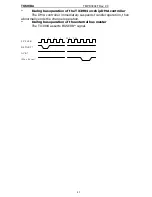
Users Manual
28
The halt bit must be set to 1 with an example flow shown below in order
to make the TX3904 halt mode. An exception must be caused when the
TX3904 is recovered form halt mode. An interrupt must not be masked.
address
instruction
comment
0x????_????
mfc0 r25, r3
# read Config register
0x????_???c
sync
#
0x????_???0
ori r25, r25, 0x100
# set HALT bit
0x????_???4
j label
#
0x????_???8
mtc0 r25, r3
# write Config register
0x????_???c label:
A store instruction which sets a halt bit in the configuration register of the TX39
processor core must be placed on an address whose low four bit is 0x8. If not, the
TMPR3904F may not return to the normal mode correctly.
6.2.3
Doze mode
The doze mode is a mode to lower power consumption by partially
halting the TX39 Processor Core
’
s operations. The difference from the
halt mode is that bus release requests from outside can be accepted
because the doze mode halts some of the clocks inside the Processor
Core. The peripheral blocks continue normal operations.
By setting the doze bit of the Config register of the TX39 Processor Core,
it shifts to the doze mode.
When having entered into the doze mode, the TX39 mega cell core halts
operations while maintaining the pipeline status. The write buffer does
not halt. Therefore, if there are remaining data in the write buffer in the
doze mode, the write operation continues until the buffer becomes
empty. The SYSCLK does not halt, either.
The doze mode is recovered from when the doze bit is cleared to 0 by
asserting the interrupts by on-chip peripherals (internal interrupt),
INT[7:0], NMI*, or RESET* signal. The value in the IntMask field of the
status register is not affected by the recovery from the doze mode. If
recovered by the RESET* signal, NMI* signal, or non-masked (internal
interrupt) and INT[7:0] signal, the corresponding exception handler is
executed. If recovered by the masked (internal interrupt) and INT[7:0]
signal, execution resumes from the instruction that follows the
instruction that was being executed when shifted to the doze mode.
6.2.4
RF (Reduced Frequency) mode
The frequency of the clock is controlled by operating the clock generator
by setting up the RF field of the Config register of the TX39 Processor
Core. When an instruction to change the RF field is executed while the
bus ownership is being released, the clock
’
s frequency is changed
without waiting for the bus ownership to be returned. Also when the RF
Summary of Contents for TMPR3904F
Page 1: ...Users Manual 32bit RISC Microprocessor TX39 family TMPR3904F Rev 2 0 Jan 12 1998 ...
Page 2: ......
Page 9: ...Users Manual 01 1 INTRODUCTION 1 1 Overview ...
Page 11: ...Users Manual 03 1 3 Kind of accessing by the TX3904 ...
Page 12: ...Users Manual 04 1 4 Precautions in the TMPR3904F specification Don t set Don t use ...
Page 13: ...Users Manual 05 Do not use ...
Page 14: ...Users Manual 06 ...
Page 15: ...Users Manual 7 2 FEATURES n n n n n n n n n n n n n ...
Page 16: ...Users Manual 8 ...
Page 18: ...Users Manual 10 ...
Page 19: ...Users Manual 11 4 PINS 4 1 Positions of Pins ...
Page 20: ...Users Manual 12 ...
Page 21: ...Users Manual 13 4 2 Functions of Pins ...
Page 22: ...Users Manual 14 ...
Page 23: ...Users Manual 15 ...
Page 24: ...Users Manual 16 ...
Page 26: ...Users Manual 18 5 2 Register Map ...
Page 27: ...Users Manual 19 ...
Page 28: ...Users Manual 20 ...
Page 30: ...Users Manual 22 5 3 2 PIO2 and PIO1 ...
Page 32: ...Users Manual 24 5 3 4 Connection of external bus master 5 3 5 INT 7 0 active status clear ...
Page 33: ...Users Manual 25 5 3 6 INT 7 0 active status set up ...
Page 34: ...Users Manual 26 ...
Page 123: ...TOSHIBA TMPR3904F Rev 2 0 115 26 ...
Page 169: ...TOSHIBA TMPR3904F Rev 2 0 161 26 ...
Page 203: ...TOSHIBA TMPR3904F Rev 2 0 195 ...
Page 230: ......
















































